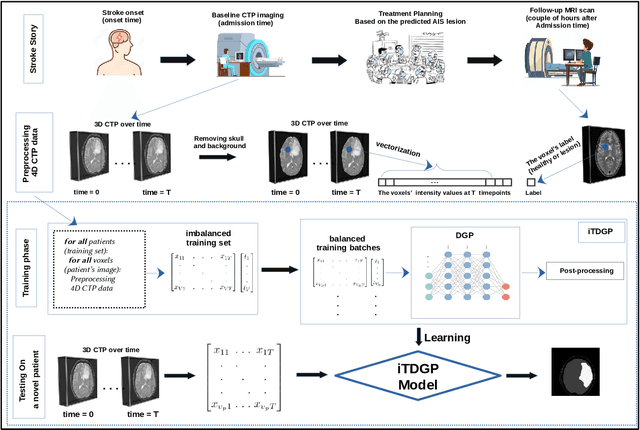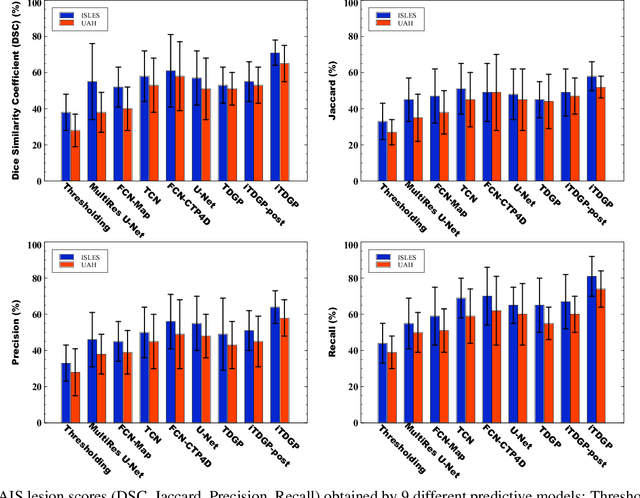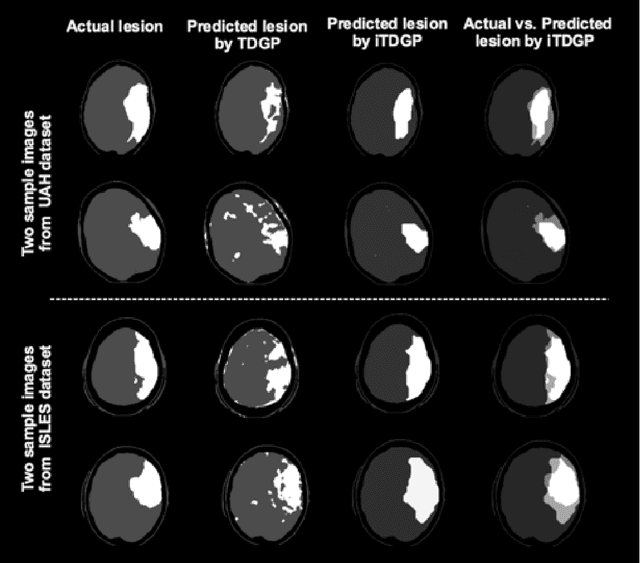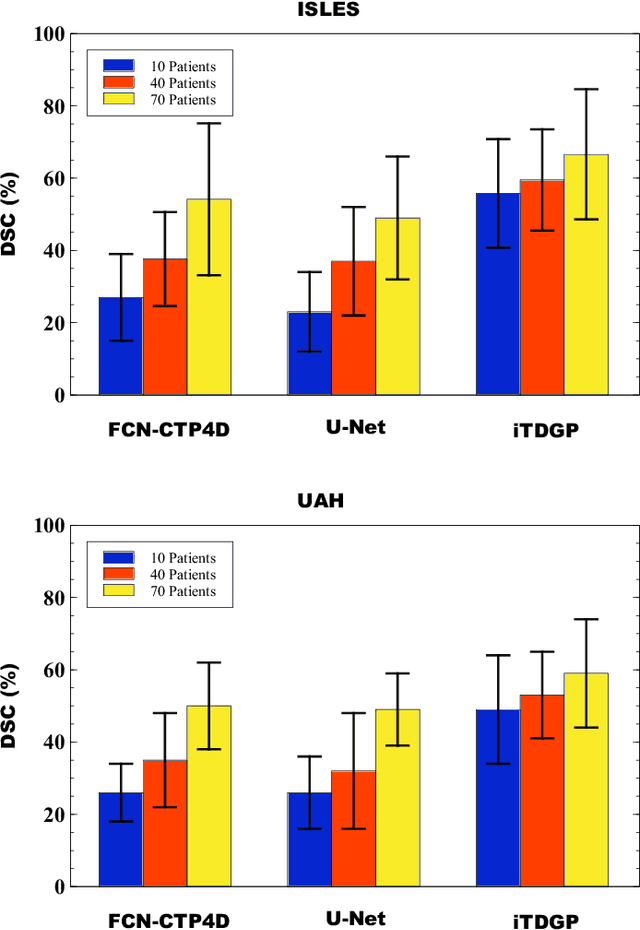Muhammad Yousefnezhad
Ischemic Stroke Lesion Prediction using imbalanced Temporal Deep Gaussian Process (iTDGP)
Nov 16, 2022



Abstract:As one of the leading causes of mortality and disability worldwide, Acute Ischemic Stroke (AIS) occurs when the blood supply to the brain is suddenly interrupted because of a blocked artery. Within seconds of AIS onset, the brain cells surrounding the blocked artery die, which leads to the progression of the lesion. The automated and precise prediction of the existing lesion plays a vital role in the AIS treatment planning and prevention of further injuries. The current standard AIS assessment method, which thresholds the 3D measurement maps extracted from Computed Tomography Perfusion (CTP) images, is not accurate enough. Due to this fact, in this article, we propose the imbalanced Temporal Deep Gaussian Process (iTDGP), a probabilistic model that can improve AIS lesions prediction by using baseline CTP time series. Our proposed model can effectively extract temporal information from the CTP time series and map it to the class labels of the brain's voxels. In addition, by using batch training and voxel-level analysis iTDGP can learn from a few patients and it is robust against imbalanced classes. Moreover, our model incorporates a post-processor capable of improving prediction accuracy using spatial information. Our comprehensive experiments, on the ISLES 2018 and the University of Alberta Hospital (UAH) datasets, show that iTDGP performs better than state-of-the-art AIS lesion predictors, obtaining the (cross-validation) Dice score of 71.42% and 65.37% with a significant p<0.05, respectively.
Shared Space Transfer Learning for analyzing multi-site fMRI data
Oct 24, 2020



Abstract:Multi-voxel pattern analysis (MVPA) learns predictive models from task-based functional magnetic resonance imaging (fMRI) data, for distinguishing when subjects are performing different cognitive tasks -- e.g., watching movies or making decisions. MVPA works best with a well-designed feature set and an adequate sample size. However, most fMRI datasets are noisy, high-dimensional, expensive to collect, and with small sample sizes. Further, training a robust, generalized predictive model that can analyze homogeneous cognitive tasks provided by multi-site fMRI datasets has additional challenges. This paper proposes the Shared Space Transfer Learning (SSTL) as a novel transfer learning (TL) approach that can functionally align homogeneous multi-site fMRI datasets, and so improve the prediction performance in every site. SSTL first extracts a set of common features for all subjects in each site. It then uses TL to map these site-specific features to a site-independent shared space in order to improve the performance of the MVPA. SSTL uses a scalable optimization procedure that works effectively for high-dimensional fMRI datasets. The optimization procedure extracts the common features for each site by using a single-iteration algorithm and maps these site-specific common features to the site-independent shared space. We evaluate the effectiveness of the proposed method for transferring between various cognitive tasks. Our comprehensive experiments validate that SSTL achieves superior performance to other state-of-the-art analysis techniques.
Deep Representational Similarity Learning for analyzing neural signatures in task-based fMRI dataset
Sep 28, 2020



Abstract:Similarity analysis is one of the crucial steps in most fMRI studies. Representational Similarity Analysis (RSA) can measure similarities of neural signatures generated by different cognitive states. This paper develops Deep Representational Similarity Learning (DRSL), a deep extension of RSA that is appropriate for analyzing similarities between various cognitive tasks in fMRI datasets with a large number of subjects, and high-dimensionality -- such as whole-brain images. Unlike the previous methods, DRSL is not limited by a linear transformation or a restricted fixed nonlinear kernel function -- such as Gaussian kernel. DRSL utilizes a multi-layer neural network for mapping neural responses to linear space, where this network can implement a customized nonlinear transformation for each subject separately. Furthermore, utilizing a gradient-based optimization in DRSL can significantly reduce runtime of analysis on large datasets because it uses a batch of samples in each iteration rather than all neural responses to find an optimal solution. Empirical studies on multi-subject fMRI datasets with various tasks -- including visual stimuli, decision making, flavor, and working memory -- confirm that the proposed method achieves superior performance to other state-of-the-art RSA algorithms.
Supervised Hyperalignment for multi-subject fMRI data alignment
Jan 09, 2020



Abstract:Hyperalignment has been widely employed in Multivariate Pattern (MVP) analysis to discover the cognitive states in the human brains based on multi-subject functional Magnetic Resonance Imaging (fMRI) datasets. Most of the existing HA methods utilized unsupervised approaches, where they only maximized the correlation between the voxels with the same position in the time series. However, these unsupervised solutions may not be optimum for handling the functional alignment in the supervised MVP problems. This paper proposes a Supervised Hyperalignment (SHA) method to ensure better functional alignment for MVP analysis, where the proposed method provides a supervised shared space that can maximize the correlation among the stimuli belonging to the same category and minimize the correlation between distinct categories of stimuli. Further, SHA employs a generalized optimization solution, which generates the shared space and calculates the mapped features in a single iteration, hence with optimum time and space complexities for large datasets. Experiments on multi-subject datasets demonstrate that SHA method achieves up to 19% better performance for multi-class problems over the state-of-the-art HA algorithms.
Gradient-based Representational Similarity Analysis with Searchlight for Analyzing fMRI Data
Sep 12, 2018



Abstract:Representational Similarity Analysis (RSA) aims to explore similarities between neural activities of different stimuli. Classical RSA techniques employ the inverse of the covariance matrix to explore a linear model between the neural activities and task events. However, calculating the inverse of a large-scale covariance matrix is time-consuming and can reduce the stability and robustness of the final analysis. Notably, it becomes severe when the number of samples is too large. For facing this shortcoming, this paper proposes a novel RSA method called gradient-based RSA (GRSA). Moreover, the proposed method is not restricted to a linear model. In fact, there is a growing interest in finding more effective ways of using multi-subject and whole-brain fMRI data. Searchlight technique can extend RSA from the localized brain regions to the whole-brain regions with smaller memory footprint in each process. Based on Searchlight, we propose a new method called Spatiotemporal Searchlight GRSA (SSL-GRSA) that generalizes our ROI-based GRSA algorithm to the whole-brain data. Further, our approach can handle some computational challenges while dealing with large-scale, multi-subject fMRI data. Experimental studies on multi-subject datasets confirm that both proposed approaches achieve superior performance to other state-of-the-art RSA algorithms.
Multi-Objective Cognitive Model: a supervised approach for multi-subject fMRI analysis
Aug 05, 2018



Abstract:In order to decode the human brain, Multivariate Pattern (MVP) classification generates cognitive models by using functional Magnetic Resonance Imaging (fMRI) datasets. As a standard pipeline in the MVP analysis, brain patterns in multi-subject fMRI dataset must be mapped to a shared space and then a classification model is generated by employing the mapped patterns. However, the MVP models may not provide stable performance on a new fMRI dataset because the standard pipeline uses disjoint steps for generating these models. Indeed, each step in the pipeline includes an objective function with independent optimization approach, where the best solution of each step may not be optimum for the next steps. For tackling the mentioned issue, this paper introduces the Multi-Objective Cognitive Model (MOCM) that utilizes an integrated objective function for MVP analysis rather than just using those disjoint steps. For solving the integrated problem, we proposed a customized multi-objective optimization approach, where all possible solutions are firstly generated, and then our method ranks and selects the robust solutions as the final results. Empirical studies confirm that the proposed method can generate superior performance in comparison with other techniques.
Gradient Hyperalignment for multi-subject fMRI data alignment
Jul 07, 2018



Abstract:Multi-subject fMRI data analysis is an interesting and challenging problem in human brain decoding studies. The inherent anatomical and functional variability across subjects make it necessary to do both anatomical and functional alignment before classification analysis. Besides, when it comes to big data, time complexity becomes a problem that cannot be ignored. This paper proposes Gradient Hyperalignment (Gradient-HA) as a gradient-based functional alignment method that is suitable for multi-subject fMRI datasets with large amounts of samples and voxels. The advantage of Gradient-HA is that it can solve independence and high dimension problems by using Independent Component Analysis (ICA) and Stochastic Gradient Ascent (SGA). Validation using multi-classification tasks on big data demonstrates that Gradient-HA method has less time complexity and better or comparable performance compared with other state-of-the-art functional alignment methods.
Deep Hyperalignment
Oct 11, 2017


Abstract:This paper proposes Deep Hyperalignment (DHA) as a regularized, deep extension, scalable Hyperalignment (HA) method, which is well-suited for applying functional alignment to fMRI datasets with nonlinearity, high-dimensionality (broad ROI), and a large number of subjects. Unlink previous methods, DHA is not limited by a restricted fixed kernel function. Further, it uses a parametric approach, rank-$m$ Singular Value Decomposition (SVD), and stochastic gradient descent for optimization. Therefore, DHA has a suitable time complexity for large datasets, and DHA does not require the training data when it computes the functional alignment for a new subject. Experimental studies on multi-subject fMRI analysis confirm that the DHA method achieves superior performance to other state-of-the-art HA algorithms.
Anatomical Pattern Analysis for decoding visual stimuli in human brains
Oct 05, 2017



Abstract:Background: A universal unanswered question in neuroscience and machine learning is whether computers can decode the patterns of the human brain. Multi-Voxels Pattern Analysis (MVPA) is a critical tool for addressing this question. However, there are two challenges in the previous MVPA methods, which include decreasing sparsity and noise in the extracted features and increasing the performance of prediction. Methods: In overcoming mentioned challenges, this paper proposes Anatomical Pattern Analysis (APA) for decoding visual stimuli in the human brain. This framework develops a novel anatomical feature extraction method and a new imbalance AdaBoost algorithm for binary classification. Further, it utilizes an Error-Correcting Output Codes (ECOC) method for multiclass prediction. APA can automatically detect active regions for each category of the visual stimuli. Moreover, it enables us to combine homogeneous datasets for applying advanced classification. Results and Conclusions: Experimental studies on 4 visual categories (words, consonants, objects and scrambled photos) demonstrate that the proposed approach achieves superior performance to state-of-the-art methods.
Multi-Region Neural Representation: A novel model for decoding visual stimuli in human brains
Dec 26, 2016



Abstract:Multivariate Pattern (MVP) classification holds enormous potential for decoding visual stimuli in the human brain by employing task-based fMRI data sets. There is a wide range of challenges in the MVP techniques, i.e. decreasing noise and sparsity, defining effective regions of interest (ROIs), visualizing results, and the cost of brain studies. In overcoming these challenges, this paper proposes a novel model of neural representation, which can automatically detect the active regions for each visual stimulus and then utilize these anatomical regions for visualizing and analyzing the functional activities. Therefore, this model provides an opportunity for neuroscientists to ask this question: what is the effect of a stimulus on each of the detected regions instead of just study the fluctuation of voxels in the manually selected ROIs. Moreover, our method introduces analyzing snapshots of brain image for decreasing sparsity rather than using the whole of fMRI time series. Further, a new Gaussian smoothing method is proposed for removing noise of voxels in the level of ROIs. The proposed method enables us to combine different fMRI data sets for reducing the cost of brain studies. Experimental studies on 4 visual categories (words, consonants, objects and nonsense photos) confirm that the proposed method achieves superior performance to state-of-the-art methods.
 Add to Chrome
Add to Chrome Add to Firefox
Add to Firefox Add to Edge
Add to Edge